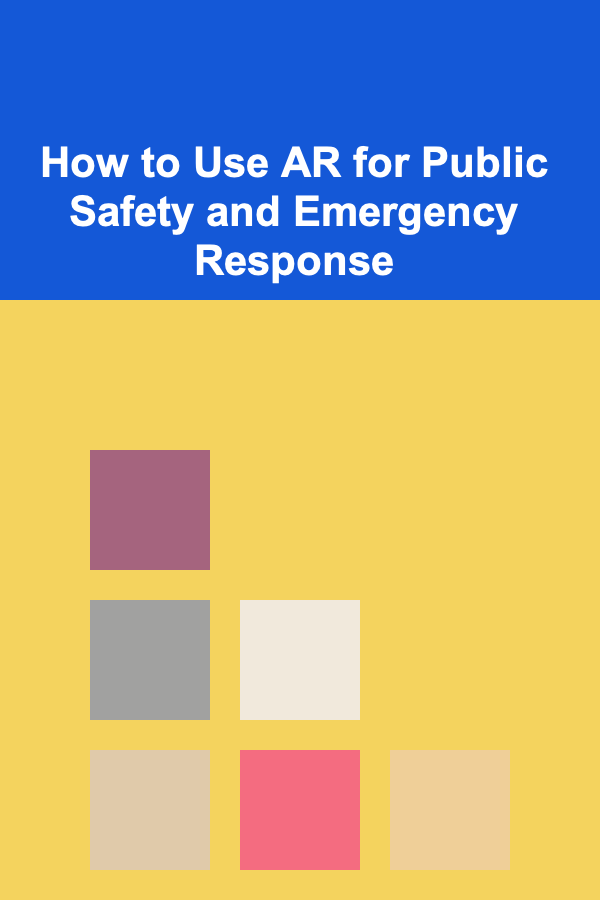
How to Use AR for Public Safety and Emergency Response
ebook include PDF & Audio bundle (Micro Guide)
$12.99$6.99
Limited Time Offer! Order within the next:

Augmented Reality (AR) is no longer a futuristic concept, but a technology that is rapidly integrating into various sectors, including public safety and emergency response. AR overlays digital information onto the real world, enhancing users' perception and interaction with their environment. In the context of public safety and emergency situations, AR has the potential to revolutionize the way first responders approach crises, making their work more efficient, informed, and safe.
In this article, we will explore how AR can be effectively used in public safety and emergency response, the key benefits, real-world applications, challenges, and future potential of this technology.
Understanding Augmented Reality (AR)
Before diving into its use in public safety, it's essential to understand what augmented reality is and how it works. AR refers to the technology that superimposes computer-generated images, sounds, or other sensory inputs onto the real-world environment. Unlike Virtual Reality (VR), which immerses the user in a fully virtual world, AR enhances the physical world with contextual information. This makes it possible for users to interact with both real and virtual elements simultaneously.
In public safety, AR allows first responders, such as police officers, firefighters, and paramedics, to receive vital real-time information while they are in the field. This information can range from building layouts to critical data about victims, traffic patterns, and hazard warnings, all of which are crucial during emergency situations.
Benefits of AR for Public Safety
2.1 Improved Decision-Making and Situational Awareness
One of the most critical aspects of emergency response is the ability to make quick, informed decisions under pressure. In high-stakes situations like fires, accidents, or active shooter scenarios, real-time information can save lives. AR enhances situational awareness by providing first responders with up-to-date data, helping them visualize critical details about the environment or the incident.
For instance, AR glasses or heads-up displays can show building schematics, hazard zones, or escape routes. Police officers responding to a dangerous incident can see real-time updates about the number of suspects, their location, and the presence of weapons, all without taking their eyes off the situation.
2.2 Hands-Free Access to Information
Emergency responders often need to act quickly and without distraction. AR allows them to access critical information without needing to stop and consult a device. For example, fire crews can receive building layouts or fire spread projections via AR glasses, enabling them to navigate unfamiliar buildings or identify areas of high risk while keeping their hands free for firefighting tasks.
This hands-free functionality improves efficiency and reduces the cognitive load on responders, allowing them to focus on the task at hand rather than sifting through papers or devices.
2.3 Real-Time Collaboration and Communication
In an emergency response scenario, teams often need to collaborate in real time, especially when coordinating efforts between different agencies or departments. AR can facilitate this communication by allowing first responders to share live data with their team members, dispatch centers, or other emergency personnel.
For example, AR can enable a paramedic at the scene of an accident to stream live footage of a victim's condition to a hospital's emergency department. The medical team can then provide guidance on treatment, ensuring that the victim receives appropriate care even before they arrive at the hospital.
2.4 Enhanced Training and Simulation
AR is a valuable tool for training public safety professionals. Traditional training methods, such as paper-based simulations or physical drills, can be expensive and logistically challenging to implement. AR-based training, on the other hand, is cost-effective, scalable, and highly immersive. Trainees can practice emergency response scenarios in a controlled environment that closely mimics real-life situations.
For instance, firefighters can use AR to simulate hazardous environments, allowing them to practice navigating smoke-filled rooms or identifying fire hazards without the risks associated with live training. Similarly, law enforcement officers can use AR to practice de-escalation techniques in virtual scenarios, improving their readiness for real-world encounters.
Real-World Applications of AR in Public Safety
3.1 AR for Firefighting and Search-and-Rescue Operations
Firefighters and search-and-rescue teams are often required to operate in hazardous and rapidly changing environments. AR can enhance their ability to make critical decisions in these situations by providing them with real-time data on building layouts, fire spread, gas leaks, and structural integrity.
For instance, AR headsets can display real-time thermal images, allowing firefighters to locate hot spots and survivors in smoke-filled buildings. Additionally, AR can overlay building blueprints onto the firefighter's field of view, helping them navigate through unfamiliar structures more efficiently.
In search-and-rescue missions, AR can help teams visualize areas that need to be searched and highlight locations of interest, such as collapsed structures or areas with low visibility, increasing the chances of finding survivors.
3.2 AR for Law Enforcement and Crime Scene Investigation
For law enforcement, AR offers several potential benefits in the field and during crime scene investigations. When investigating a crime scene, officers can use AR glasses or smartphones to overlay information such as suspect descriptions, witness statements, or evidence locations onto their field of view.
AR can also assist in real-time criminal pursuit. Imagine a police officer chasing a suspect through a crowded area---AR could provide directions, highlight potential escape routes, and display real-time traffic information, all of which would be crucial for making timely decisions.
Additionally, AR technology can be used in training law enforcement officers for high-pressure scenarios, such as hostage situations or active shooter incidents, allowing them to practice responses in a realistic virtual environment before facing such challenges in real life.
3.3 AR for Medical Emergency Response
In medical emergencies, AR can provide paramedics and emergency medical technicians (EMTs) with vital information about a patient's medical history, allergies, and previous treatments. This can be especially useful in cases where the patient is unresponsive, and family members are unavailable to provide details.
For example, AR glasses could display a patient's medical record, medication list, or emergency contact information, allowing EMTs to make more informed decisions on-site. Additionally, AR can help paramedics visualize the best treatment protocols for specific injuries or conditions, improving the chances of a successful outcome.
Moreover, AR could aid in performing complex medical procedures, such as CPR or intubation, by providing real-time guidance and step-by-step instructions to emergency responders.
3.4 AR for Disaster Management and Crisis Response
In large-scale disasters such as earthquakes, floods, or terrorist attacks, AR can play a critical role in coordinating emergency response efforts. By providing a real-time, digital overlay of the affected area, AR can assist first responders in mapping out damage, identifying hazardous zones, and optimizing evacuation routes.
For example, AR could be used to create a live, interactive map that shows where survivors are located, which areas are blocked, and which routes are most accessible. In addition, AR can help responders visualize the locations of key resources such as medical supplies, shelters, and power sources, improving logistical efficiency during a crisis.
Challenges in Implementing AR for Public Safety
Despite its potential, the adoption of AR in public safety and emergency response is not without challenges. Some of the key barriers to widespread implementation include:
4.1 High Costs
Implementing AR technology can be costly, particularly for smaller agencies or departments with limited budgets. The hardware, software, and training required to use AR effectively can represent a significant investment, which may be difficult for some organizations to justify, especially in the public sector.
4.2 Technological Limitations
While AR technology has advanced significantly, it still faces limitations in terms of reliability and performance. For example, AR devices such as glasses or headsets can be heavy, uncomfortable, or prone to technical malfunctions. Additionally, the quality of AR displays may be affected by environmental factors such as lighting or weather conditions, making it difficult to rely on the technology in all situations.
4.3 Privacy and Security Concerns
AR systems that collect and transmit real-time data, such as video footage or location information, raise privacy and security concerns. In the context of public safety, it is essential to ensure that sensitive data is protected and that AR systems comply with relevant privacy laws and regulations.
The Future of AR in Public Safety and Emergency Response
Looking ahead, the potential for AR in public safety and emergency response is vast. As technology continues to evolve, AR is likely to become more integrated into first responders' daily operations. Some of the advancements we can expect include:
5.1 Integration with AI and IoT
The integration of AR with Artificial Intelligence (AI) and the Internet of Things (IoT) will further enhance its capabilities in public safety. For instance, AI could be used to analyze real-time data from AR systems, helping first responders make quicker and more accurate decisions. IoT devices could provide real-time updates on environmental conditions, such as temperature, air quality, or radiation levels, which could be overlaid onto AR systems to provide more comprehensive situational awareness.
5.2 Lightweight and Advanced AR Wearables
In the future, we can expect to see more lightweight, comfortable, and durable AR wearables, such as smart glasses or contact lenses. These devices will provide seamless, hands-free access to vital information, making it easier for first responders to stay focused on the task at hand.
5.3 Widespread Adoption and Standardization
As AR technology becomes more affordable and accessible, it is likely that we will see broader adoption across different public safety sectors. Furthermore, the development of industry standards and protocols will help ensure that AR systems are interoperable and can be used effectively across various emergency response scenarios.
Conclusion
Augmented Reality holds immense potential for improving public safety and emergency response. By providing real-time data, enhancing situational awareness, and enabling hands-free access to vital information, AR can help first responders make more informed decisions, respond more efficiently, and save lives. While challenges such as high costs and technological limitations remain, the future of AR in public safety is promising, with advancements in AI, IoT, and wearable technology paving the way for broader adoption and more effective emergency response strategies.

How to Use Deep Learning to Automate and Maximize Your Passive Income
Read More
How to Let ChatGPT Help You Learn New Skills
Read More
How to Build Resilience in Times of Adversity
Read More
How to Book Affordable Accommodation
Read More
How to Use Social Media for Personal Branding
Read More
10 Tips for Fall Landscaping: Preparing Your Yard for Winter
Read MoreOther Products

How to Use Deep Learning to Automate and Maximize Your Passive Income
Read More
How to Let ChatGPT Help You Learn New Skills
Read More
How to Build Resilience in Times of Adversity
Read More
How to Book Affordable Accommodation
Read More
How to Use Social Media for Personal Branding
Read More